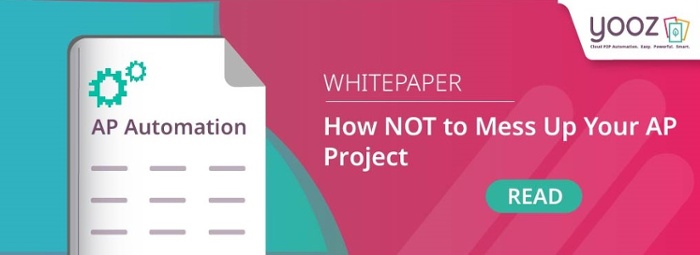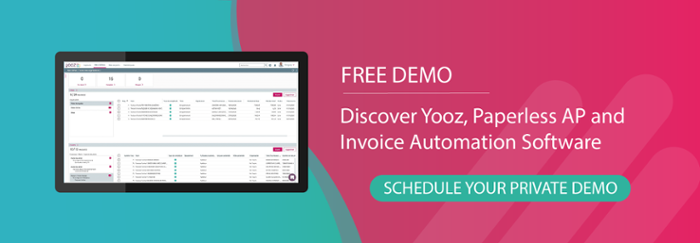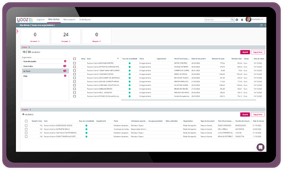If you’re reading this, you’re probably already aware of many of the benefits offered by Accounts Payable automation software. You may even already be researching it as a viable means to streamline and optimize your accounting processes.
If this is the case, you’re in good (and growing) company. Today many businesses are starting to see the value in automation and have already begun their own Accounts Payable software research. While this is a good thing, they key word here is “many.”
According to statistics by AccountingToday, the accounting software market will have a global value of $1.8 billion by 2026, with an expansion rate of 8.6% per year.[1] But for all its projected growth, approximately 45% of SMEs still fall into the “novice” category of Accounts Payable efficiency. According to PaymentsJournal, this means that they're still entering data, coding invoices, and routing processes manually.[2]
From both an accounting and business perspective, this also means that these same SMEs are missing out on a cost-effective solution for human error and process inefficiencies. And not just SMEs; the use of AP automation can greatly benefit business of all sizes.
As the future beckons, let’s take a quick look at the history of Accounts Payable and, as a result, how automation is set to revolutionize the accounting industry. This information will arm you with valuable insights to begin or continue your own Accounts Payable software comparison and to find the best Accounts Payable software in 2023.
Beginning with the paper-based, manual process
No Accounts Payable comparison would be complete without looking back to see how far we’ve come. Before automation existed in finance, especially in accounting, all the steps in the Accounts Payable workflow were performed manually and on paper. Invoices were hand-written or (eventually) printed, sent to the appropriate employee for processing, purchase order matching, and eventually approval. A payment would then be authorized and check written. Finally, all relevant documents would be transported and physically stored in the designated location.
The entire process was tedious and time consuming, often taking long periods of time and equally difficult to track. Human error was rampant, paper-based records would disappear, and supplier relationships were damaged when invoices went unpaid. Indeed, to discourage this from happening suppliers often charged late fees which only meant an increase in both costs and expenses.
Regardless of how much companies would try streamline the process, the physical movement required by the forms throughout the process automatically and consistently presented a problem. Change was clearly needed.
Digitalization and Accounts Receivable
The development of Electronic Data Interchange (EDI) software systems in the 1960s provided a foundation of change for financial departments, specifically in the areas of accounting and accounts payable. Using this new method, documents could be processed by computers instead of by hand. This in turn boosted efficiency, helped to improve the speed of transactions, and created a foundation for process standardization.
As computers became more widespread throughout the workplace, the implementation of digital processes accelerated. E-mail became standard and as a result, the speed of invoice processing picked up. However, since not all processes were digitalized, both manual tasks and paper-based communication continued (including record transportation and storage).
AP automation and software today
Today, we’re in a better position. Technology has moved far past EDI. The rapid evolution of artificial intelligence, cloud-based automation tools, and machine learning technology – and the combination of all three - has resulted in a wealth of innovative automation software solutions being introduced into the market. This is especially relevant regarding finance and accounting. Why? Essentially, AP automation software leverages intelligent technology to streamline and optimize each feature of the invoice process for accounting departments and companies. That means faster, more accurate, and cost-efficient results.
Indeed, businesses that have automated some aspects of their AP process are noticing a definitive, positive effect on their overall business financial health. They are cutting purchase-to-pay expenses, boosting efficiency and reactivity, enjoying faster processing time, and of course saving on the associated costs of using paper. Not to mention that less time spent handling and searching for paper documents means employees can focus on tasks that contribute to business growth in a tangible way. In addition, these same businesses are often using automation to drive overall company digital transformation.
However, while better than nothing, a piecemeal style automation process will not sustain competitiveness in today’s technologically evolving - and online -environment. To take full advantage of automation, businesses need to implement a complete software solution that contains the entire AP process within a single system.
Why do it? What are the advantages of end-to-end AP Automation software?
Without question, looking at Accounts Payable software and manual processes side-by-side exposes the inefficiencies of the latter. Whereas manual AP relies on accountants’ typing skills for data entry, AP automation drives more than £10.47 savings per invoice and reduces invoice processing and approval workflow time by 50 percent.
Other notable benefits include:
- Improved tracking and piloting activity.
- Quick, hassle-free management of account closing periods.
- 24/7 access to digital invoices, account data and analytical data, using any network device that’s configured for your system.
- Commitment and expenditure tracking lead to improved budget monitoring and forecasting capacity.
- End-to-end traceability and transparency of interventions make for a reliable, secure accounting process.
Finally, an often-forgotten benefit of AP automation is that it can improve service to and business relations with vendors. Not only in terms of rapid approval and paying on time but in the ability to track an invoice throughout the entire payable process, quickly answering any questions along the way. For this reason alone, your research of Accounts Payable software platforms needs to be thorough to find the best fit for your business.
Laying the foundation
Without knowing where you are currently at makes it hard to map the path to where you want to arrive. Therefore, the first step of any research effort should be evaluating the current business state and needs versus where you want to be and want to achieve. Taking the following steps will help:
-
Map out your existing payments process to uncover the existing bottlenecks. This includes asking stakeholders their opinions and experiences.
-
Start thinking about how things can be automated, even writing out ideal rules and processes.
-
Recognize the influence of group mindset and feelings. Having everybody on board and with a similar mindset will smooth any implementation process so start preparing staff ahead of time.
In addition to these and before you begin comparing potential Accounts Payable solutions, ensure that you have the following:
- A clear understanding of all invoice validation circuits, including workflow complexity and interdependence.
- An accurate idea of the volume of invoices you expect to receive.
- A precise set of numbers for costs and processing time related to invoice management.
Of course, don't forget to record everything.
What to look for in an AP automation solution?
Once you’ve laid the foundations and have agreed on clear objectives, you can start your Accounts Payable software comparison to find the ideal solution for your organization. When researching, consider the following:
Coexistence: An AP automation software solution needs to work with your existing software systems. Before committing, make sure it can integrate easily with your ERP, CRM, and accounting solutions. Ideally, there should be a seamless and real-time exchange of information between the systems.
Full process and workflow coverage: Your software platform must cover all processes and workflows to maximize performance. To automate the data entry and invoice validation process effectively, the solution must be primed for multichannel capture from all document types in multiple formats. Even better, the ideal capture should be by intelligent software that can learn and improve over time. This will also help in the elimination of opportunities for error and fraudulent activity.
End-to-end traceability: The software solution must have user authentication mechanisms in place, as well as secure classification and electronic archiving for all operations. This will help manage the process, facilitate the ability to quickly respond to any questions, and of course establish an audit trail to ensure compliance.
Always-on customer support: Whether for onboarding or platform expansions, there will always be questions or hiccups. Therefore, the supplier needs to provide 24/7 top-class support and assistance, which includes an easily accessible hotline and web chat for ongoing training or quick troubleshooting.
One final caution is to be patient. Once you’re informed and everything documented, give yourself the opportunity to find the right fit for your needs. Also, recognize that once the software is implemented, no matter how fast or efficient, the process still takes time to be truly successful. You will experience rapid (and immediate) advantages, but AI must have time to learn. The good news? Once automation is implemented, you’ll continue to experience positives after positives!
Questions? Reach out to us. Yooz delivers the highest automation rate by industry standards combined with extreme simplicity to help accounting teams and finance leaders tackle their challenges from purchase-to-payment.
Get a sneak peek of how best-in-class AP Automation solutions can automate your entire Purchase-to-Pay process quickly and easily and reduce your costs by 80%.
Yooz: Pioneering AP Automation in the Accounts Payable Software Comparison Arena
Yooz emerges as the premier choice in any accounts payable software comparison. Leveraging cutting-edge technologies such as Artificial Intelligence (AI), Deep Learning, and Robotic Process Automation (RPA), Yooz achieves an impressive 80% invoice automation rate without the need for prior configuration. Its hallmark lies in seamlessly integrating real-time AI performance with simplicity, enabling users to initiate operations within an hour, without the necessity for training. Yooz's comprehensive All-in-One platform streamlines the procure-to-pay (P2P) process, encompassing everything from purchase request to payment, providing unparalleled convenience. With a client base exceeding 5,000 and a global presence extending across various regions, Yooz demonstrates extensive experience and international reach, making it a standout choice in accounts payable software comparison. The platform's Plug-and-Play functionality enhances its attractiveness, boasting over 250 native connectors for seamless integration. Its steadfast focus on automatic document processing and continuous innovation underscores its dedication to enhancing efficiency and effectiveness. Established as a Cloud-based solution, Yooz has experienced remarkable growth, earning recognition from prestigious awards and endorsements from top accounting firms worldwide. With nine out of ten leading firms recommending Yooz to their clients, its reputation is firmly established. In essence, Yooz distinguishes itself through its unparalleled features, simplicity, and global recognition, solidifying its position as the top choice in AP automation.

.jpg)







